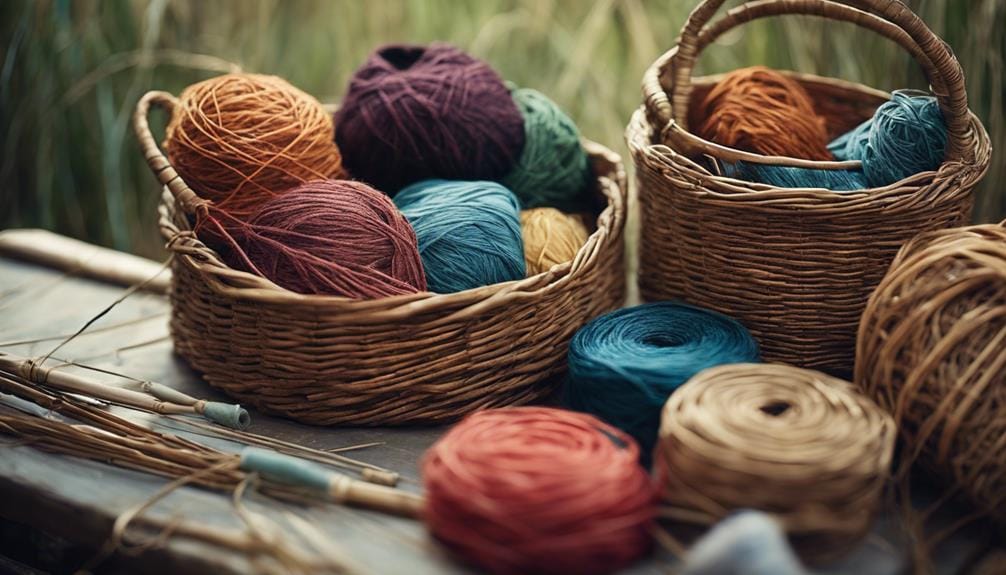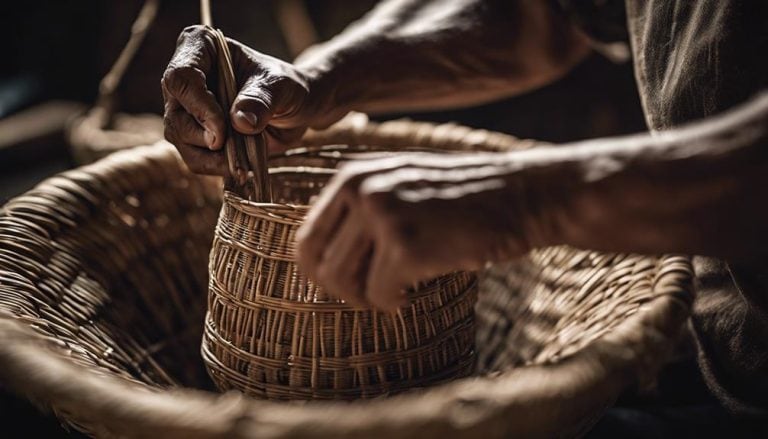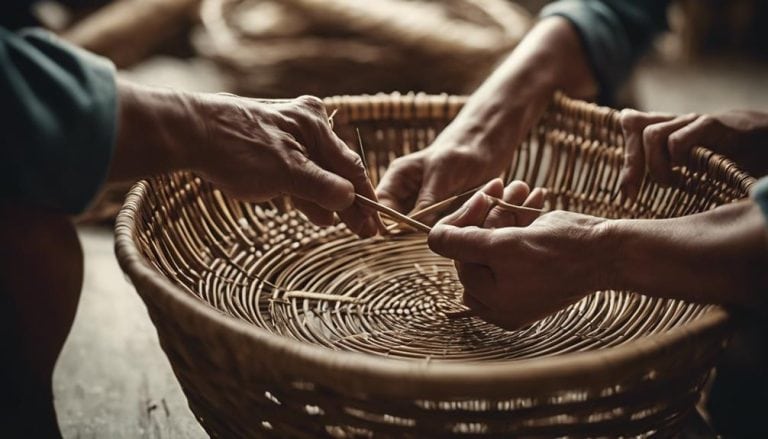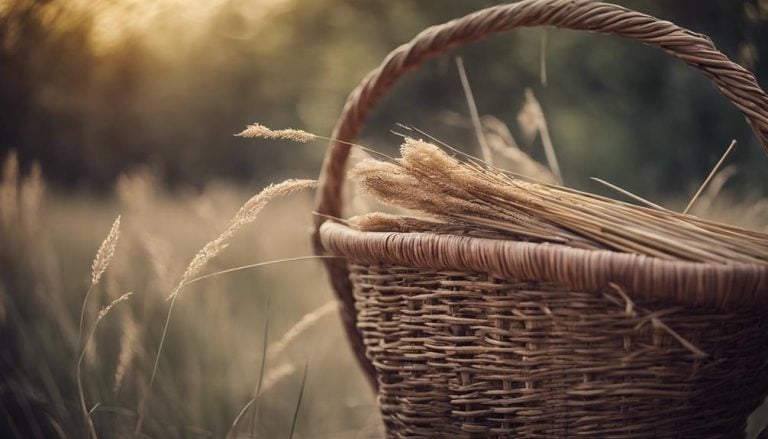Choosing the Right Materials for Basket Weaving
As a weaver, selecting the right materials for basket weaving is akin to choosing the perfect ingredients for a culinary masterpiece. The interplay of materials like rattan, willow, and bamboo can determine the basket’s strength, flexibility, and aesthetic appeal.
But how do these elements harmonize to create a functional and visually pleasing end product? Understanding the nuances of each material’s properties is just the beginning; unraveling the complexities of color selection, texture combinations, and tool proficiency is where the true artistry lies. So, let’s embark on this journey of material exploration and craftsmanship together.
To choose the right materials for basket weaving, consider the type of basket you want to make and the properties of the materials. Flexibility, durability, and texture can affect the final product.
Key Takeaways
- Select traditional or modern materials based on sustainability, texture, and color for diverse creative possibilities.
- Consider reed and seagrass types for stability, flexibility, and intricate designs in basket weaving projects.
- Utilize essential materials like natural fibers, synthetic alternatives, and decorative embellishments for durable and unique pieces.
- Source basket weaving materials responsibly from eco-friendly suppliers to reduce environmental impact and support ethical practices.
Types of Traditional Basket Weaving Materials
My hands instinctively reach for the natural fibers of willow, bamboo, grasses, vines, and twigs when it comes to traditional basket weaving materials. These materials connect me to ancient weaving traditions and embody sustainability through their renewability. Willow and bamboo, in particular, stand out for their fast growth and abundance, making them staples in traditional basket weaving.
The rich texture and varied color palette these natural fibers offer allow for endless creative possibilities in basket making. From the earthy tones of willow to the vibrant hues of dyed bamboo, each material adds depth and character to the final woven piece.
Working with these fibers is a tactile experience like no other, feeling the smoothness of bamboo contrasted with the ruggedness of twigs. Embracing these traditional materials honors indigenous cultures’ weaving heritage and fosters a deep connection to the environment and its resources.
Modern Alternatives for Basket Weaving
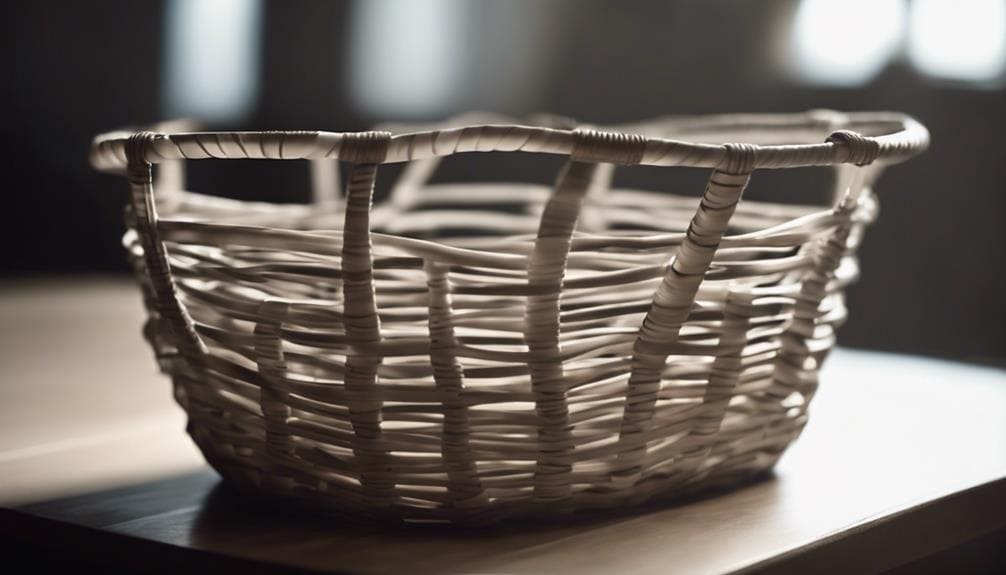
Exploring the realm of basket weaving opens up a world of innovative possibilities using modern alternatives that blend sustainability and creativity. Incorporating eco-friendly fibers and unconventional textures into basket weaving projects promotes environmental consciousness and adds a unique touch to traditional crafts.
Sustainable materials like recycled fibers, plastic tubing, paper twine, and nylon cords offer contemporary designs with various colors and textures. These modern alternatives contribute to reducing waste and bring a fresh and artistic perspective to basket weaving. In my experience, materials such as paracord, t-shirt yarn, and fabric strips have revolutionized the possibilities in basket weaving, providing versatility and allowing for intricate and creative designs.
Moreover, integrating unconventional materials like wire, leather strips, and fabric remnants can result in truly innovative and artistic basket creations that stand out for their modern aesthetic. Embracing these modern alternatives in basket weaving opens up a world of endless creative opportunities while contributing to a more sustainable approach to crafting.
Understanding Different Types of Reed

In my exploration of basket weaving materials, understanding the different types of reeds is essential for creating diverse and intricate designs. Reed’s characteristics determine a woven basket’s final look and feel. Here are some key points to consider:
- Flat Reed: This type of reed is balanced on both sides and is ideal for various weaving techniques, offering stability and structure to the baskets.
- Oval-Oval Reed: Rounded on both sides, this reed provides a smooth finish to woven baskets, adding a touch of elegance to the design.
- Round Reed: With cylindrical shapes and different diameters available, round reed offers flexibility in creating intricate patterns and designs due to its versatility.
Understanding these reed characteristics will help you select the right material for your project and master weaving techniques to bring your basket-weaving creations to life.
Exploring Seagrass in Basket Weaving
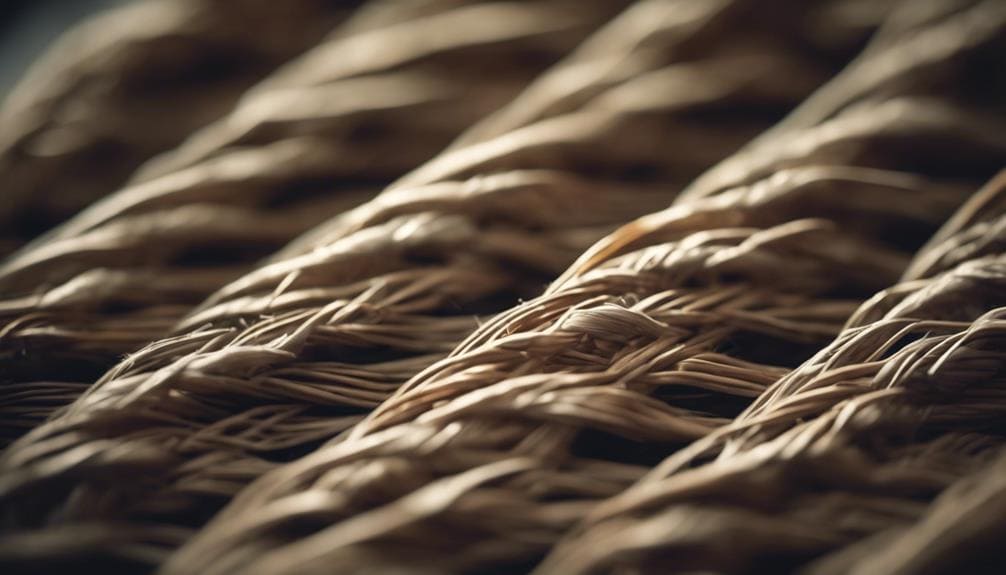
Seagrass stands out as a versatile and sustainable material that enhances the intricacy and durability of woven baskets. Harvested from marshes and coastal areas, seagrass is eco-friendly, boasts a smooth texture, and comes in light green to brown color options, adding a natural aesthetic to your basketry projects.
Its flexibility and durability make it ideal for creating intricate designs and patterns, allowing for the perfect blend of strength and beauty in your weavings. When working with seagrass, its pliability makes it easy to weave and complements other materials like rattan, willow, and bamboo, offering endless creative possibilities for your basket projects.
Other Essential Basket Weaving Materials
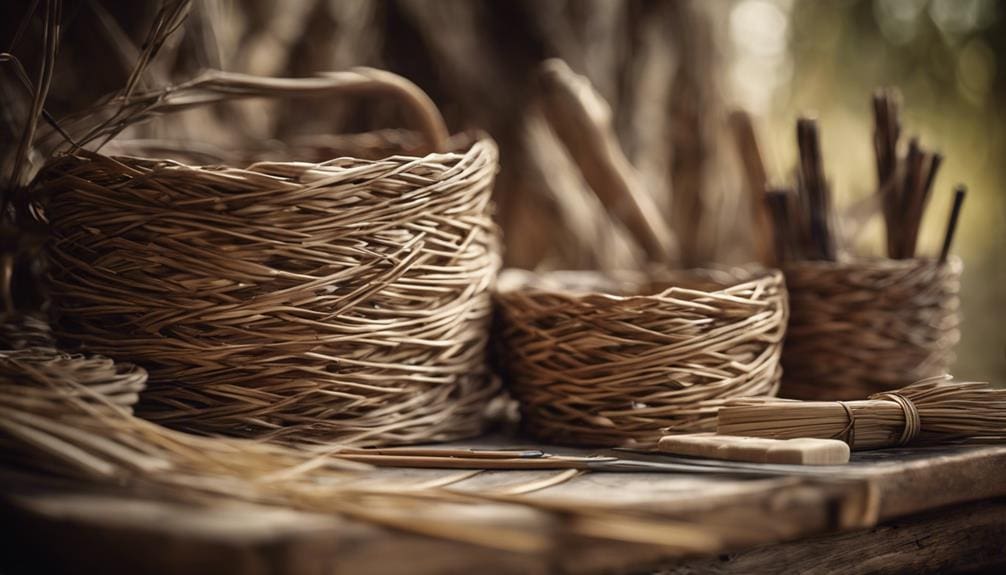
A diverse array of materials is essential for creating unique and durable baskets that showcase a blend of traditional craftsmanship and modern creativity. Regarding basket weaving, the choice of materials can greatly impact the final product.
Here are some other essential basket-weaving materials to consider:
- Natural fibers, synthetic alternatives: Materials like seagrass, raffia, ash splints, and chairs can offer a variety of textures and colors to work with. Synthetic alternatives can provide durability and a modern twist to traditional designs.
- Decorative embellishments, functional additions: Specialty items such as smoked reed, extra materials packs, and teacher specials can add flair to your baskets. These decorative elements can elevate the overall aesthetic appeal of your creations.
- Tools for success: Dyes, stains, bases, and weaving tools are crucial for achieving the desired look and structural integrity of your baskets. Investing in quality tools ensures a smoother weaving process and a professional finish.
When chosen thoughtfully, these materials can enhance your basket weaving experience and result in beautiful, functional pieces.
All About Basket Handles
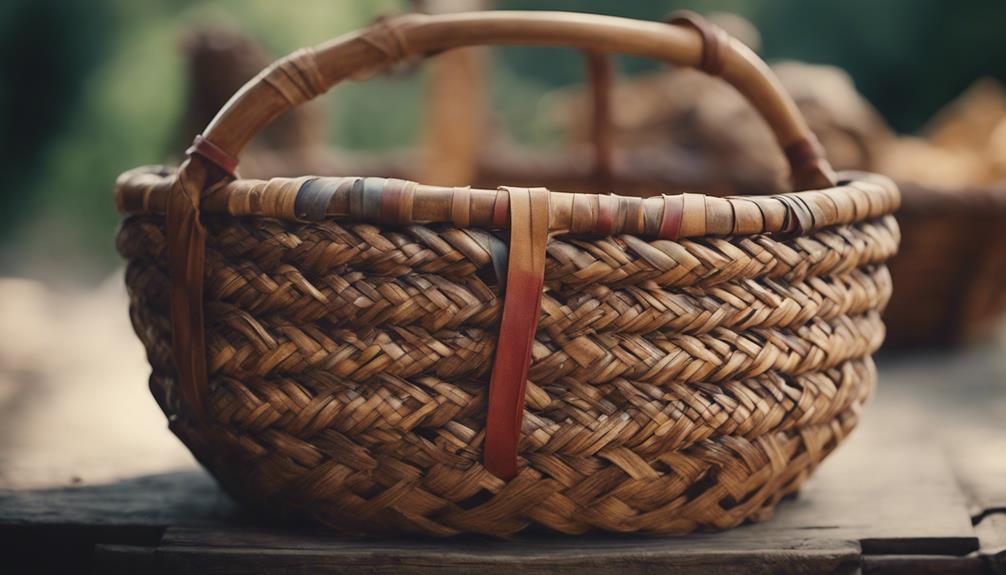
Crafting basket handles is a meticulous process that requires attention to both functionality and aesthetics. When it comes to handling designs, there are various options to consider. From classic loop handles to sturdy fixed handles or even intricately woven adjustable handles, each design serves a unique purpose and adds character to the basket.
As a passionate weaver, I have found that handle placement is crucial; they should be visually appealing and ergonomically positioned for easy lifting and carrying.
| Handle Designs | Material Options | Attachment Methods |
|---|---|---|
| Loop Handles | Rattan, Willow | Weaving Techniques |
| Fixed Handles | Bamboo, Leather | Rivets |
| Adjustable Handles | Metal | Screws |
Proper basket handle maintenance is essential for the longevity of your creation. Regularly check for loose attachments, especially with riveted or screwed handles, and ensure that woven handles are securely fastened. By caring for your basket handles, you can enjoy their functionality and beauty for years.
What Are the Best Materials for Basket Weaving for Beginners?
For basket weaving beginners, using quality basket weaving materials professionals recommend is crucial. Materials like reed, cane, and willow are popular for beginners due to their flexibility and durability. These materials are easy to work with and can help beginners easily create beautiful woven baskets.
Where to Source Basket Weaving Materials
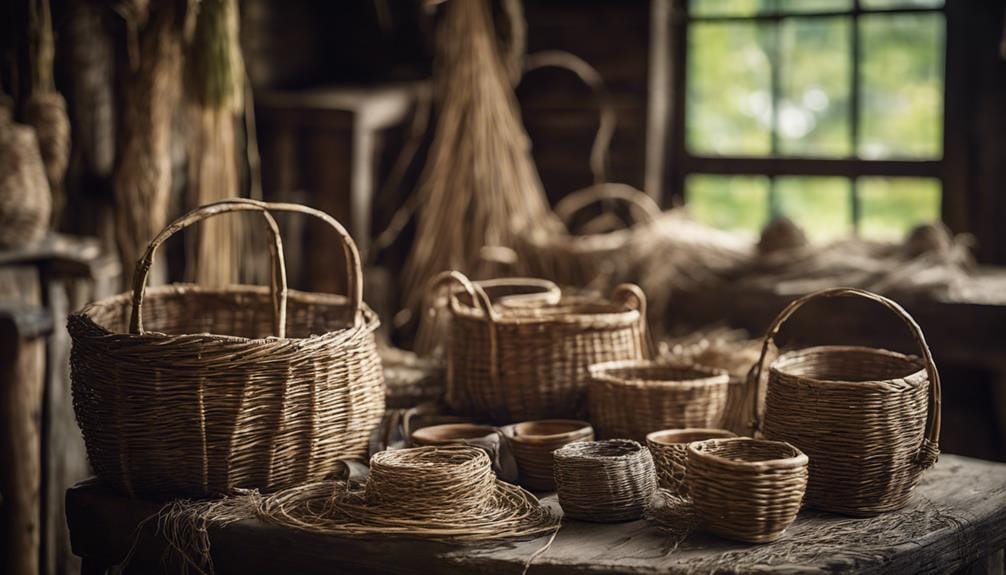
As a dedicated basket weaver, finding high-quality materials is key to creating sturdy and visually appealing baskets that stand the test of time. When it comes to where to source basket weaving materials, there are a few options to consider:
- Online vs. Local sources: Online stores offer various materials, often at competitive prices, and can provide access to unique or specialty items. On the other hand, local craft stores or farmers’ markets can offer a more hands-on shopping experience, allowing you to feel the materials and support local businesses.
- Eco-friendly options: To reduce environmental impact, consider sourcing materials like willow, bamboo, or grasses from sustainable sources. Look for suppliers who prioritize eco-friendly practices in harvesting and processing their materials, ensuring that your basket weaving hobby is both fulfilling and environmentally conscious.
- Specialty stores: Stores like Textile Indie Shop specialize in basket weaving materials. They offer a curated selection of high-quality rattan-based supplies such as basket reed, favored for their durability and flexibility in creating intricate designs.
Frequently Asked Questions
What Is the Best Material for Basket Weaving?
Natural materials like willow and bamboo offer traditional charm and flexibility for basket weaving, while synthetics provide modern options. I love the vibrant colors of natural fibers, blending traditional and modern elements for unique creations.
What Materials Are Appropriate for the Type of Basket?
Natural fibers offer tradition for the type of basket, while synthetic options give modern twists. I craft with both honoring heritage and exploring innovation. My creations blend techniques, weaving stories into functional art.
Which of the Following Materials Is the Best in Basket Making?
Regarding basket making, I find that natural fibers like rattan and willow weavers offer the best combination of flexibility and strength. They connect me to traditional methods while allowing for modern creativity.
How Do You Gather Materials for Basket Weaving?
Gathering materials for basket weaving is like a treasure hunt in nature. I seek out vines like grapevine and honeysuckle, preferring natural over synthetic materials. Sustainability is key, ensuring my craft honors the earth.
Conclusion
As I finish up my latest basket weaving project, I can’t help but marvel at the beauty and versatility of the materials I’ve used. Like weaving different strands together to create a unique design, each material brings charm and character to the final piece. It’s like painting a masterpiece with nature’s palette, each element adding depth and texture to the finished product. Basket weaving truly is a timeless art form that allows us to connect with the natural world meaningfully.

